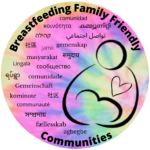STEP 4: During pregnancy, all families in the community are informed about the benefits of chest/breastfeeding, as well as about the risks of unnecessary formula use, and where to access support as needed.
STEP 7: The businesses and organizations in the community welcome chest/breastfeeding families.
Ten Steps to a Breastfeeding Family Friendly Community
All community-based organizations, such as, local agencies (local WIC, local health department, local Chamber of Commerce, etc.), (inter)national organizations working locally, faith-based communities, local non-profit organizations, social organizations, and others are encouraged to provide families with positive messages about breastfeeding, chestfeeding, and human milk feeding.
We All Benefit.
- Breastfeeding saves lives! Human milk is always clean; requires no fuel, water, or electricity; and is always available, even in the most dire circumstances.
- Human milk contains antibodies that fight infection, including ear infections, diarrhea and respiratory infections common among infants in emergency situations and in childcare environments.
- Human milk provides infants with perfect nutrition, including the proper amount of vitamins and minerals required for normal growth.
- Infants who are exclusively breastfed tend to need fewer health care visits, prescriptions, and hospitalizations resulting in a lower total medical care cost compared to never-breastfed infants.
- Breastfeeding releases hormones that lower stress and anxiety in both babies and parents.
- Breast milk changes to meet the baby’s changing needs and promotes normal brain development
- The safest baby food is the parent’s own milk. Donor human milk is the next best option. Parents who cannot directly feed their babies also can be supported to express their milk.
- Parents who are stressed can continue to make milk. A quiet area to help parents relax can help their milk flow to the baby; however, parents can breastfeed even without the support of a quiet space.
- If a baby (or parent) becomes ill, the best thing the parent can do is to continue breastfeeding to provide baby with human antibodies that fight the illness.
- Support makes the difference!
Encouraging Affirmations of Support
All community non-profit, social, and faith-based organizations can choose to provide a variety of information, education and resources for families during pregnancy and after the baby is born. This helps parents to make informed choices about infant feeding and building support among family and friends. We encourage the following affirmations of support:
- Breastfeeding families are always welcomed and respected. They will never be treated poorly, asked to stop breastfeeding, or asked to cover up or move.
- We do not promote infant formula, coupons, or related products nor provide infant formula or other breastmilk substitutes unless instructed by the family. We do not accept gifts of infant feeding products from manufacturers nor display infant feeding products.
- All lactating employees are allowed breaks to express milk or nurse their children and access to a private space for expressing milk or nursing. The space is not a bathroom; is lockable and shielded from view; includes an electrical outlet; and has hand hygiene available.
Creating a Breastfeeding Friendly Environment
- Build Relationships – Have a discussion within your organization about how you will support breastfeeding.
- Keep It Measurable – encourage your organizations to apply for any and all existing breastfeeding-friendly designations
- Appoint a Leader– Choose members of your organization to be breastfeeding family friendly advocates, who will work to create or enhance a breastfeeding friendly environment in your organization or place of worship.
- Post Signage – Post the International Breastfeeding Symbol, or a sign or poster, in a visible position near the entrance indicating that families are welcome to breastfeed their children while in your facilities.
- Distribute Digital and Printed Material ∫Provide culturally-appropriate materials (e.g., images and languages that represent the diversity in your community) on the benefits of breastfeeding (online or hard copy).
- Provide a Space – Provide a clean, comfortable, private space (not a bathroom) to allow staff to express their milk and to accommodate staff and other parents who may wish to nurse their infants in private while in the facilities, while welcoming breastfeeding throughout the facility.
- Write a Policy – Create guidelines and/or an official policy to support breastfeeding in your community organization or congregation.
Additional Information for Selected Community Non-Profit, Social, and Faith-based Organizations
- Breastfeeding Family Friendly Community Centers
- Breastfeeding Family Friendly Community Pools
- Breastfeeding Family Friendly Food Pantries
- Breastfeeding Family Friendly Places of Worship
- Breastfeeding Family Friendly Public Libraries
- WIC Breastfeeding Award of Excellence Program
Achieving Steps 4 and 7 Measures
Step 4 Measures: Distribute breastfeeding materials* that are:
- Non-commercial
- Reflective of the population and culturally appropriate
- In hard copy and/or online
- Produced or approved by your local team, the Designating Group
*These materials can come from your local health sector, breastfeeding support groups, or breastfeeding coalition.
Step 7 Measures: Community organizations have signed a form (see Ten Steps Approaches and Measures) that they welcome chest/breastfeeding in their places of business and display welcome signs or the “Breastfeeding Welcome Here” logo (e.g. window clings). These may be provided by your local team.
